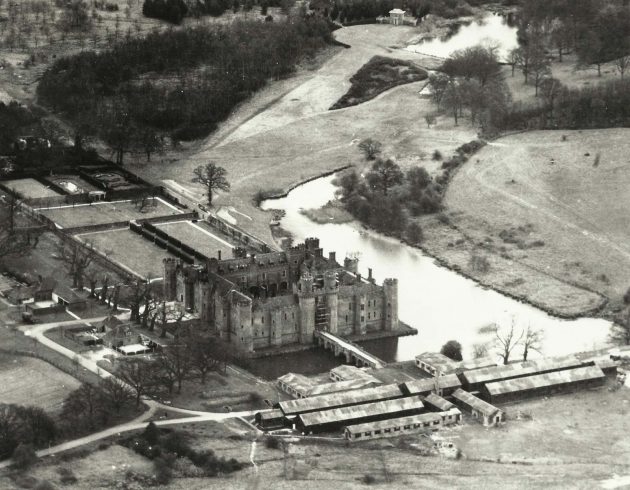…where east meets west
- Home
- Brief History
- The Greenwich Meridian
- Greenwich
(1675–1958) - Herstmonceux
(1948–1990) - Cambridge
(1990–1998) - Outstations (1822–1971)…
- – Chingford (1822–1924)
- – Deal
(1864–1927) - – Abinger
(1923–1957) - – Bristol & Bradford on Avon
(1939–1948) - – Bath
(1939–1949) - – Hartland
(1955–1967) - – Cape of Good Hope
(1959–1971)
- Administration…
- – Funding
- – Governance
- – Inventories
- – Pay
- – Regulations
- – Royal Warrants
- Contemporary Accounts
- People
- Publications
- Science
- Technology
- Telescopes
- Chronometers
- Clocks & Time
- Board of Longitude
- Libraries & Archives
- Visit
- Search
Aerial views of Herstmonceux Castle showing the wartime hutments
Erected at the start of World War Two as office and sleeping accommodation for the Hearts of Oak Benefit Society whose headquarters were evacuated to the Castle from London in 1939, the hutments formed part of the estate acquired by the Admiralty when it was purchased as the new home for the Royal Observatory in 1947. They were subsequently converted for Observatory use until such time as more permanent buildings could be erected elsewhere on the estate. The first of the wartime buildings to be demolished was the hut in the courtyard, which was removed in 1952/3. Apart from a number of air raid shelters, the rest were cleared in early 1958, after the completion of the West Building and the Equatorial Group. The last of the air raid shelters were removed in 1977/8.

Herstmonceux Castle and hutments c.1950. To the left of the Castle, three of the estate cottages can be seen. On the extreme left is the detached cottage occupied by the Head Messenger, Mr A Lankford. To its right are two semi-detached cottages that were initially occupied by workmen from Chatham and known as No.1 and No.2 Garage Cottages. The Astronomer Royal's private quarters were in the east wing of the castle (on the right). His car was kept in the garages adjoining the cottage of the Head Messenger. The open space at the end of the bridge leading to the Castle was known as the South Courtyard. The hutments to its right and left were occupied the Nautical Almanac Office; the Machine Section containing the Hollerith machines being in the U-shaped block, and the ordinary office accommodation in the L-shaped one. The small hutment on the south side of South Court is the boiler house. It stood in the middle of a row of three hutments facing the roadway. The one to its left had its left hand section converted into the temporary chronometer workshop (the office, packing and rating rooms being accommodated in the Castle). The smaller hut at the left end of the range (which is slightly nearer the camera) became an extension to the chronometer workshop. The hutment below the main chronometer workshop was used as a hostel for the workers from Chatham, the smaller hutment beneath it being the hostel for the male Observatory staff. The entrances to the air-raid shelters can be seen just above the road immediately to the left of hutments occupied by the Nautical Almanac Office. Photo courtesy of Herstmonceux Castle Archives
Images taken by Aerofilms in 1946 & 1948 in the archives of Heritage England
With one exception, the links below are arranged in pairs showing the Castle as seen from roughly the same angle on each of the two dates. They are ordered in a clockwise direction, starting with views from the east and ending with views from the west. In the 1948 images, some of the workmen stationed at Herstmonceux to convert the hutments for Observatory use can be seen.
The first image provides the best view of the hutment in the Castle courtyard that was used as a dining room. The air raid shelter was located to the west of the western end of the moat. The various views suggest it had five entrances as well as several escape hatches, two of which can be clearly seen in the last image, where one is open.
The images can be viewed on either the Historic England or the Britain from Above website. The images can be viewed at high resolution on both sites, but to do so on the Britain from Above website you need to log in. The Britain from Above site also allows logged in users to leave comments. Some of these are incorrect and as such caution is required when reading them.
Date |
Historic England ref. |
Britain from Above ref. |
Source* |
|
| 1948, Apr 13 | EAW014362 | EAW014362 | Negative (damaged) |
|
| 1946, Jul 03 | EAW001455 | EAW001455 | ||
| 1948, Apr 13 | EAW014359 | EAW014359 | ||
| 1946, Jul 03 | EAW001454 | EAW001454 | ||
| 1948, Apr 13 | EAW014361 | EAW014361 | ||
| 1948, Apr 13 | EAW014360 | EAW014360 | ||
| 1946, Jul 03 | EAW001453 | EAW001453 |
* Where no source is indicated, it is assumed that the digital image has been created from the original negative.
© 2014 – 2025 Graham Dolan
Except where indicated, all text and images are the copyright of Graham Dolan